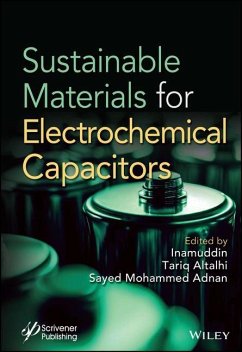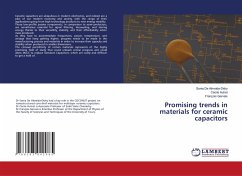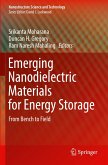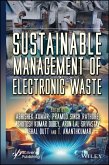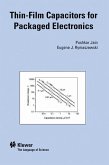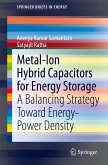Sustainable Materials for Electrochemcial Capacitors
Herausgeber: Inamuddin; Adnan, Sayed Mohammed; Altalhi, Tariq
Sustainable Materials for Electrochemcial Capacitors
Herausgeber: Inamuddin; Adnan, Sayed Mohammed; Altalhi, Tariq
- Gebundenes Buch
- Merkliste
- Auf die Merkliste
- Bewerten Bewerten
- Teilen
- Produkt teilen
- Produkterinnerung
- Produkterinnerung
The book highlights the properties of sustainable materials for the production of commercial electrochemical capacitors. Sustainable Materials for Electrochemical Capacitors details the progress in the usage of ubiquitous environmentally sustainable materials. Due to their cost effectiveness, flexible forms, frequent accessibility, and environmentally friendly nature, electrochemical capacitors with significant surface areas of their carbon components are quite common. Many novel ways for using bio-derived components in highly efficient electrochemical capacitors are being established as a…mehr
Andere Kunden interessierten sich auch für
![Promising trends in materials for ceramic capacitors Promising trends in materials for ceramic capacitors]() Sonia De Almeida-DidryPromising trends in materials for ceramic capacitors36,99 €
Sonia De Almeida-DidryPromising trends in materials for ceramic capacitors36,99 €![Emerging Nanodielectric Materials for Energy Storage Emerging Nanodielectric Materials for Energy Storage]() Emerging Nanodielectric Materials for Energy Storage125,99 €
Emerging Nanodielectric Materials for Energy Storage125,99 €![Introduction to Network Analysis Introduction to Network Analysis]() Prakash Gajanan BuradeIntroduction to Network Analysis39,99 €
Prakash Gajanan BuradeIntroduction to Network Analysis39,99 €![Electrical and Electronic Devices, Circuits, and Materials Electrical and Electronic Devices, Circuits, and Materials]() Electrical and Electronic Devices, Circuits, and Materials278,99 €
Electrical and Electronic Devices, Circuits, and Materials278,99 €![Sustainable Management of Electronic Waste Sustainable Management of Electronic Waste]() Sustainable Management of Electronic Waste241,99 €
Sustainable Management of Electronic Waste241,99 €![Thin-Film Capacitors for Packaged Electronics Thin-Film Capacitors for Packaged Electronics]() Jain PushkarThin-Film Capacitors for Packaged Electronics83,99 €
Jain PushkarThin-Film Capacitors for Packaged Electronics83,99 €![Metal-Ion Hybrid Capacitors for Energy Storage Metal-Ion Hybrid Capacitors for Energy Storage]() Aneeya Kumar SamantaraMetal-Ion Hybrid Capacitors for Energy Storage53,49 €
Aneeya Kumar SamantaraMetal-Ion Hybrid Capacitors for Energy Storage53,49 €-
-
-
The book highlights the properties of sustainable materials for the production of commercial electrochemical capacitors. Sustainable Materials for Electrochemical Capacitors details the progress in the usage of ubiquitous environmentally sustainable materials. Due to their cost effectiveness, flexible forms, frequent accessibility, and environmentally friendly nature, electrochemical capacitors with significant surface areas of their carbon components are quite common. Many novel ways for using bio-derived components in highly efficient electrochemical capacitors are being established as a consequence of current research, and this book provides details of all these developments. The book provides: * A broad overview of properties explored for the development of electrochemical capacitors; * Introduces potential applications of electrochemical capacitors; * Highlights sustainable materials exploited for the production of electrochemical capacitors; * Presents commercial potential of electrochemical capacitors. Audience This is a useful guide for engineers, materials scientists, physicists, and innovators, who are linked to the development and applications of electrochemical capacitors.
Hinweis: Dieser Artikel kann nur an eine deutsche Lieferadresse ausgeliefert werden.
Hinweis: Dieser Artikel kann nur an eine deutsche Lieferadresse ausgeliefert werden.
Produktdetails
- Produktdetails
- Verlag: Wiley
- Seitenzahl: 464
- Erscheinungstermin: 20. September 2023
- Englisch
- Gewicht: 1061g
- ISBN-13: 9781394166237
- ISBN-10: 1394166230
- Artikelnr.: 64695581
- Herstellerkennzeichnung
- Libri GmbH
- Europaallee 1
- 36244 Bad Hersfeld
- 06621 890
- Verlag: Wiley
- Seitenzahl: 464
- Erscheinungstermin: 20. September 2023
- Englisch
- Gewicht: 1061g
- ISBN-13: 9781394166237
- ISBN-10: 1394166230
- Artikelnr.: 64695581
- Herstellerkennzeichnung
- Libri GmbH
- Europaallee 1
- 36244 Bad Hersfeld
- 06621 890
Inamuddin, PhD, is an assistant professor in the Department of Applied Chemistry, Aligarh Muslim University, Aligarh, India. He has extensive research experience in the multidisciplinary fields of analytical chemistry, materials chemistry, electrochemistry, renewable energy, and environmental science. He has published about 190 research articles in various international scientific journals, 18 book chapters, and 60 edited books with multiple well-known publishers. Tariq Altalhi, PhD, is Head of the Department of Chemistry and Vice Dean of Science College at Taif University, Saudi Arabia. He received his PhD from the University of Adelaide, Australia in 2014. His research interests include developing advanced chemistry-based solutions for solid and liquid municipal waste management, converting plastic bags to carbon nanotubes, and fly ash to efficient adsorbent material. He also researches natural extracts and their application in the generation of value-added products such as nanomaterials. Sayed Mohammed Adnan, PhD, is a faculty member of the Department of Chemical Engineering, Zakir Husain College of Engineering and Technology, Faculty of Engineering and Technology, Aligarh Muslim University, India.
Preface xv
1 Sustainable Materials for Electrochemical Supercapacitors: Eco Materials
1
R. Kumar and R. Thangappan
1.1 Introduction 1
1.2 Eco-Carbon-Based Electrode Materials 3
1.3 Eco-Metal Oxide-Based Electrode Materials 8
1.4 Eco-Carbon-Based Material/Metal Oxide Composite Electrode Materials 11
1.5 Conclusion 13
2 Solid Waste-Derived Carbon Materials for Electrochemical Capacitors 19
Shreeganesh Subraya Hegde and Badekai Ramachandra Bhat
2.1 Introduction 19
2.2 Solid Waste as a Source of CNS 20
2.3 Preparation and Activation Methods of Solid Waste-Derived CNS 23
2.4 Effect of Structural and Morphological Diversities on Electrochemical
Performance 25
2.5 Environmental Trash-Derived CNS in Electrochemical Capacitors 26
2.6 Challenges and Future Prospects 27
2.7 Conclusions 27
3 Metal Hydroxides 33
Rida Fatima, Sania Naseer, Muhammad Rehan Hasan Shah Gilani, Muhammad Aamir
and Javeed Akhtar
3.1 Introduction 33
3.2 Method to Fabricate Metal Hydroxide 34
3.3 Properties and Applications of MOHs 36
3.4 Examples of Metal Hydroxide 49
3.5 Conclusions 57
4 Porous Organic Polymers: Genres, Chemistry, Synthetic Strategies, and
Diversified Applications 65
V. Renuga
4.1 Introduction 65
4.2 Family of Porous Organic Materials 70
4.3 Conclusions and Perspectives 112
5 Gel-Type Natural Polymers as Electroconductive Materials 133
Arshpreet Kaur, Madhvi and Dhiraj Sud
5.1 Introduction 133
5.2 Natural Polymers 134
5.3 Synthesis Methods for Fabrication of Natural Polymer-Based Hydrogels
144
5.4 Natural Polymer-Based Physically Cross-Linked Hydrogels 147
5.5 Properties of Natural Polymer-Based Hydrogels 148
5.6 Stimuli Sensitivity of Hydrogels 150
5.7 Application of Hydrogels as Electrochemical Supercapacitors 150
5.8 Conducting Polymer Hydrogels as Electrode Materials 154
5.9 Conducting Polymer Hydrogels as Electrolyte Materials 156
5.10 Conclusion 159
6 Ionic Liquids for Supercapacitors 167
Guocai Tian
6.1 Introduction 167
6.2 Brief Introduction of Supercapacitor 169
6.3 Ionic Liquids and Its Unique Properties 174
6.4 Application of Ionic Liquids in Supercapacitors 181
6.5 Conclusion and Prospective 193
7 Functional Binders for Electrochemical Capacitors 205
Purnima Baruah and Debajyoti Mahanta
7.1 Introduction 205
7.2 Characteristics of Binder 206
7.3 Method of Fabricating Supercapacitor Electrode 207
7.4 Mechanism of Binding Process 207
7.5 Classification of Binders 208
7.6 Characterization Techniques 209
7.7 Conventional Binders and Related Issues 209
7.8 Sustainable Binders 210
7.9 Conclusion 216
8 Sustainable Substitutes for Fluorinated Electrolytes in Electrochemical
Capacitors 221
Sina Yaghoubi, Seyyed Mojtaba Mousavi, Seyyed Alireza Hashemi, Aziz
Babapoor and Chin Wei Lai
8.1 Introduction 221
8.2 Fluorinated Electrolytes 224
8.3 Sustainable Substitutes for Fluorinated Electrolytes 227
8.4 Performance of Sustainable Electrolytes Compared to Fluorinated
Electrolytes 234
8.5 Final Remarks 236
9 Aqueous Redox-Active Electrolytes 247
Ranganatha S.
9.1 Introduction 247
9.2 Effect of the Electrolyte on Supercapacitor Performance 248
9.3 Aqueous Electrolytes 250
9.4 Acidic Electrolytes 251
9.5 Alkaline Electrolytes 252
9.6 Neutral Electrolyte 254
9.7 Conclusion and Future Research Directions 257
10 Biodegradable Electrolytes 261
Tuba Saleem, Ijaz Rasul, Habibullah Nadeem, Sanora Sehar and Arfaa Sajid
10.1 Introduction 261
10.2 Classification of Biodegradable Electrolytes 263
10.3 Preparation of Biodegradable Electrolytes 268
10.4 Some Defined Ways to Increase the Ionic Conductivity 268
10.5 Factors Affecting Ion Conduction of Biodegradable Polymer Electrolytes
269
10.6 Properties of Ideal Biodegradable Electrolyte System 270
10.7 Applications of Biodegradable Electrolytes 270
10.8 Conclusion 273
11 Supercapattery: An Electrochemical Energy Storage Device 279
Fiona Joyline Mascarenhas, Shreeganesh Subraya Hegde and Badekai
Ramachandra Bhat
11.1 Introduction 279
11.2 Batteries and Capacitors 280
11.3 Supercapattery Device and Electrode Materials 281
11.4 Advantages and Challenges of Supercapatteries 287
11.5 Conclusions 287
12 Ceramic Multilayers and Films for High-Performance Supercapacitors 291
Sonali Verma, Bhavya Padha and Sandeep Arya
12.1 Introduction 291
12.2 Different Types of Ceramic Materials 292
12.3 Multilayer Structure 293
12.4 Supercapacitors Based on Ceramic Materials 294
12.5 Challenges and Prospects 297
12.6 Conclusion 298
13 Potential Applications in Sustainable Supercapacitors 305
Pitchaimani Veerakumar
13.1 Introduction 306
13.2 Fundamentals and Components of SCs 307
13.3 Sustainable Nanomaterials in SCs 311
13.4 Sustainable Carbon Nanomaterials for Energy Storage 315
13.5 Conclusions 325
14 Wearable Supercapacitors 339
Preety Ahuja, Sanjeev Kumar Ujjain, M. Ramanand Singh, Neelu Dheer and
Rajni Kanojia
14.1 Introduction 339
14.2 Working Principle 340
14.3 Design of Electrode Materials 342
14.4 Wearable Supercapacitor 346
14.5 Integrated Application 350
14.6 Conclusion 354
15 Electrospun Materials 361
Hina Sahar, Sania Naseer, Muhammad Rehan Hasan Shah Gilani, Syed Ali Raza
Naqvi, Muhammad Aamir and Javeed Akhtar
15.1 Introduction 361
15.2 Electrospinning Process 362
15.3 Advantages of Electrospinning Technique 363
15.4 Working Parameters of Electrospinning Process 363
15.5 Electrospinning-Based Preparation Methods for Nanofibers 367
15.6 Formation of Pore in Electrospun Polymer Fibers 368
15.7 Modification of Electrospun Micro- and Nanofibers 371
15.8 Applications 375
15.9 Conclusion 382
16 Polysaccharide Biomaterials for Electrochemical Applications 391
Neelam Srivastava and Dipti Yadav
16.1 Introduction 391
16.2 Polysaccharides in Energy Devices 393
17 Polymer Inks for Printable Supercapacitors 415
Yurui Liu, Yijie Zhou and Yanfei Xu
17.1 Introduction 415
17.2 Screen Printing 419
17.3 Inkjet Printing 419
17.4 3D Printing 419
17.5 Conclusion and Outlook 422
18 Biomass-Derived Carbon for Supercapacitors 427
Priyadharshini M., Pazhanivel T. and Hariprasath K. R.
18.1 Introduction 428
18.2 Tuneable Physiochemical Properties 429
18.3 Synthesis Procedure 432
18.4 Main Categories of Biomass 432
18.5 Conclusion and Future Perspective 436
References 437
Index 441
1 Sustainable Materials for Electrochemical Supercapacitors: Eco Materials
1
R. Kumar and R. Thangappan
1.1 Introduction 1
1.2 Eco-Carbon-Based Electrode Materials 3
1.3 Eco-Metal Oxide-Based Electrode Materials 8
1.4 Eco-Carbon-Based Material/Metal Oxide Composite Electrode Materials 11
1.5 Conclusion 13
2 Solid Waste-Derived Carbon Materials for Electrochemical Capacitors 19
Shreeganesh Subraya Hegde and Badekai Ramachandra Bhat
2.1 Introduction 19
2.2 Solid Waste as a Source of CNS 20
2.3 Preparation and Activation Methods of Solid Waste-Derived CNS 23
2.4 Effect of Structural and Morphological Diversities on Electrochemical
Performance 25
2.5 Environmental Trash-Derived CNS in Electrochemical Capacitors 26
2.6 Challenges and Future Prospects 27
2.7 Conclusions 27
3 Metal Hydroxides 33
Rida Fatima, Sania Naseer, Muhammad Rehan Hasan Shah Gilani, Muhammad Aamir
and Javeed Akhtar
3.1 Introduction 33
3.2 Method to Fabricate Metal Hydroxide 34
3.3 Properties and Applications of MOHs 36
3.4 Examples of Metal Hydroxide 49
3.5 Conclusions 57
4 Porous Organic Polymers: Genres, Chemistry, Synthetic Strategies, and
Diversified Applications 65
V. Renuga
4.1 Introduction 65
4.2 Family of Porous Organic Materials 70
4.3 Conclusions and Perspectives 112
5 Gel-Type Natural Polymers as Electroconductive Materials 133
Arshpreet Kaur, Madhvi and Dhiraj Sud
5.1 Introduction 133
5.2 Natural Polymers 134
5.3 Synthesis Methods for Fabrication of Natural Polymer-Based Hydrogels
144
5.4 Natural Polymer-Based Physically Cross-Linked Hydrogels 147
5.5 Properties of Natural Polymer-Based Hydrogels 148
5.6 Stimuli Sensitivity of Hydrogels 150
5.7 Application of Hydrogels as Electrochemical Supercapacitors 150
5.8 Conducting Polymer Hydrogels as Electrode Materials 154
5.9 Conducting Polymer Hydrogels as Electrolyte Materials 156
5.10 Conclusion 159
6 Ionic Liquids for Supercapacitors 167
Guocai Tian
6.1 Introduction 167
6.2 Brief Introduction of Supercapacitor 169
6.3 Ionic Liquids and Its Unique Properties 174
6.4 Application of Ionic Liquids in Supercapacitors 181
6.5 Conclusion and Prospective 193
7 Functional Binders for Electrochemical Capacitors 205
Purnima Baruah and Debajyoti Mahanta
7.1 Introduction 205
7.2 Characteristics of Binder 206
7.3 Method of Fabricating Supercapacitor Electrode 207
7.4 Mechanism of Binding Process 207
7.5 Classification of Binders 208
7.6 Characterization Techniques 209
7.7 Conventional Binders and Related Issues 209
7.8 Sustainable Binders 210
7.9 Conclusion 216
8 Sustainable Substitutes for Fluorinated Electrolytes in Electrochemical
Capacitors 221
Sina Yaghoubi, Seyyed Mojtaba Mousavi, Seyyed Alireza Hashemi, Aziz
Babapoor and Chin Wei Lai
8.1 Introduction 221
8.2 Fluorinated Electrolytes 224
8.3 Sustainable Substitutes for Fluorinated Electrolytes 227
8.4 Performance of Sustainable Electrolytes Compared to Fluorinated
Electrolytes 234
8.5 Final Remarks 236
9 Aqueous Redox-Active Electrolytes 247
Ranganatha S.
9.1 Introduction 247
9.2 Effect of the Electrolyte on Supercapacitor Performance 248
9.3 Aqueous Electrolytes 250
9.4 Acidic Electrolytes 251
9.5 Alkaline Electrolytes 252
9.6 Neutral Electrolyte 254
9.7 Conclusion and Future Research Directions 257
10 Biodegradable Electrolytes 261
Tuba Saleem, Ijaz Rasul, Habibullah Nadeem, Sanora Sehar and Arfaa Sajid
10.1 Introduction 261
10.2 Classification of Biodegradable Electrolytes 263
10.3 Preparation of Biodegradable Electrolytes 268
10.4 Some Defined Ways to Increase the Ionic Conductivity 268
10.5 Factors Affecting Ion Conduction of Biodegradable Polymer Electrolytes
269
10.6 Properties of Ideal Biodegradable Electrolyte System 270
10.7 Applications of Biodegradable Electrolytes 270
10.8 Conclusion 273
11 Supercapattery: An Electrochemical Energy Storage Device 279
Fiona Joyline Mascarenhas, Shreeganesh Subraya Hegde and Badekai
Ramachandra Bhat
11.1 Introduction 279
11.2 Batteries and Capacitors 280
11.3 Supercapattery Device and Electrode Materials 281
11.4 Advantages and Challenges of Supercapatteries 287
11.5 Conclusions 287
12 Ceramic Multilayers and Films for High-Performance Supercapacitors 291
Sonali Verma, Bhavya Padha and Sandeep Arya
12.1 Introduction 291
12.2 Different Types of Ceramic Materials 292
12.3 Multilayer Structure 293
12.4 Supercapacitors Based on Ceramic Materials 294
12.5 Challenges and Prospects 297
12.6 Conclusion 298
13 Potential Applications in Sustainable Supercapacitors 305
Pitchaimani Veerakumar
13.1 Introduction 306
13.2 Fundamentals and Components of SCs 307
13.3 Sustainable Nanomaterials in SCs 311
13.4 Sustainable Carbon Nanomaterials for Energy Storage 315
13.5 Conclusions 325
14 Wearable Supercapacitors 339
Preety Ahuja, Sanjeev Kumar Ujjain, M. Ramanand Singh, Neelu Dheer and
Rajni Kanojia
14.1 Introduction 339
14.2 Working Principle 340
14.3 Design of Electrode Materials 342
14.4 Wearable Supercapacitor 346
14.5 Integrated Application 350
14.6 Conclusion 354
15 Electrospun Materials 361
Hina Sahar, Sania Naseer, Muhammad Rehan Hasan Shah Gilani, Syed Ali Raza
Naqvi, Muhammad Aamir and Javeed Akhtar
15.1 Introduction 361
15.2 Electrospinning Process 362
15.3 Advantages of Electrospinning Technique 363
15.4 Working Parameters of Electrospinning Process 363
15.5 Electrospinning-Based Preparation Methods for Nanofibers 367
15.6 Formation of Pore in Electrospun Polymer Fibers 368
15.7 Modification of Electrospun Micro- and Nanofibers 371
15.8 Applications 375
15.9 Conclusion 382
16 Polysaccharide Biomaterials for Electrochemical Applications 391
Neelam Srivastava and Dipti Yadav
16.1 Introduction 391
16.2 Polysaccharides in Energy Devices 393
17 Polymer Inks for Printable Supercapacitors 415
Yurui Liu, Yijie Zhou and Yanfei Xu
17.1 Introduction 415
17.2 Screen Printing 419
17.3 Inkjet Printing 419
17.4 3D Printing 419
17.5 Conclusion and Outlook 422
18 Biomass-Derived Carbon for Supercapacitors 427
Priyadharshini M., Pazhanivel T. and Hariprasath K. R.
18.1 Introduction 428
18.2 Tuneable Physiochemical Properties 429
18.3 Synthesis Procedure 432
18.4 Main Categories of Biomass 432
18.5 Conclusion and Future Perspective 436
References 437
Index 441
Preface xv
1 Sustainable Materials for Electrochemical Supercapacitors: Eco Materials
1
R. Kumar and R. Thangappan
1.1 Introduction 1
1.2 Eco-Carbon-Based Electrode Materials 3
1.3 Eco-Metal Oxide-Based Electrode Materials 8
1.4 Eco-Carbon-Based Material/Metal Oxide Composite Electrode Materials 11
1.5 Conclusion 13
2 Solid Waste-Derived Carbon Materials for Electrochemical Capacitors 19
Shreeganesh Subraya Hegde and Badekai Ramachandra Bhat
2.1 Introduction 19
2.2 Solid Waste as a Source of CNS 20
2.3 Preparation and Activation Methods of Solid Waste-Derived CNS 23
2.4 Effect of Structural and Morphological Diversities on Electrochemical
Performance 25
2.5 Environmental Trash-Derived CNS in Electrochemical Capacitors 26
2.6 Challenges and Future Prospects 27
2.7 Conclusions 27
3 Metal Hydroxides 33
Rida Fatima, Sania Naseer, Muhammad Rehan Hasan Shah Gilani, Muhammad Aamir
and Javeed Akhtar
3.1 Introduction 33
3.2 Method to Fabricate Metal Hydroxide 34
3.3 Properties and Applications of MOHs 36
3.4 Examples of Metal Hydroxide 49
3.5 Conclusions 57
4 Porous Organic Polymers: Genres, Chemistry, Synthetic Strategies, and
Diversified Applications 65
V. Renuga
4.1 Introduction 65
4.2 Family of Porous Organic Materials 70
4.3 Conclusions and Perspectives 112
5 Gel-Type Natural Polymers as Electroconductive Materials 133
Arshpreet Kaur, Madhvi and Dhiraj Sud
5.1 Introduction 133
5.2 Natural Polymers 134
5.3 Synthesis Methods for Fabrication of Natural Polymer-Based Hydrogels
144
5.4 Natural Polymer-Based Physically Cross-Linked Hydrogels 147
5.5 Properties of Natural Polymer-Based Hydrogels 148
5.6 Stimuli Sensitivity of Hydrogels 150
5.7 Application of Hydrogels as Electrochemical Supercapacitors 150
5.8 Conducting Polymer Hydrogels as Electrode Materials 154
5.9 Conducting Polymer Hydrogels as Electrolyte Materials 156
5.10 Conclusion 159
6 Ionic Liquids for Supercapacitors 167
Guocai Tian
6.1 Introduction 167
6.2 Brief Introduction of Supercapacitor 169
6.3 Ionic Liquids and Its Unique Properties 174
6.4 Application of Ionic Liquids in Supercapacitors 181
6.5 Conclusion and Prospective 193
7 Functional Binders for Electrochemical Capacitors 205
Purnima Baruah and Debajyoti Mahanta
7.1 Introduction 205
7.2 Characteristics of Binder 206
7.3 Method of Fabricating Supercapacitor Electrode 207
7.4 Mechanism of Binding Process 207
7.5 Classification of Binders 208
7.6 Characterization Techniques 209
7.7 Conventional Binders and Related Issues 209
7.8 Sustainable Binders 210
7.9 Conclusion 216
8 Sustainable Substitutes for Fluorinated Electrolytes in Electrochemical
Capacitors 221
Sina Yaghoubi, Seyyed Mojtaba Mousavi, Seyyed Alireza Hashemi, Aziz
Babapoor and Chin Wei Lai
8.1 Introduction 221
8.2 Fluorinated Electrolytes 224
8.3 Sustainable Substitutes for Fluorinated Electrolytes 227
8.4 Performance of Sustainable Electrolytes Compared to Fluorinated
Electrolytes 234
8.5 Final Remarks 236
9 Aqueous Redox-Active Electrolytes 247
Ranganatha S.
9.1 Introduction 247
9.2 Effect of the Electrolyte on Supercapacitor Performance 248
9.3 Aqueous Electrolytes 250
9.4 Acidic Electrolytes 251
9.5 Alkaline Electrolytes 252
9.6 Neutral Electrolyte 254
9.7 Conclusion and Future Research Directions 257
10 Biodegradable Electrolytes 261
Tuba Saleem, Ijaz Rasul, Habibullah Nadeem, Sanora Sehar and Arfaa Sajid
10.1 Introduction 261
10.2 Classification of Biodegradable Electrolytes 263
10.3 Preparation of Biodegradable Electrolytes 268
10.4 Some Defined Ways to Increase the Ionic Conductivity 268
10.5 Factors Affecting Ion Conduction of Biodegradable Polymer Electrolytes
269
10.6 Properties of Ideal Biodegradable Electrolyte System 270
10.7 Applications of Biodegradable Electrolytes 270
10.8 Conclusion 273
11 Supercapattery: An Electrochemical Energy Storage Device 279
Fiona Joyline Mascarenhas, Shreeganesh Subraya Hegde and Badekai
Ramachandra Bhat
11.1 Introduction 279
11.2 Batteries and Capacitors 280
11.3 Supercapattery Device and Electrode Materials 281
11.4 Advantages and Challenges of Supercapatteries 287
11.5 Conclusions 287
12 Ceramic Multilayers and Films for High-Performance Supercapacitors 291
Sonali Verma, Bhavya Padha and Sandeep Arya
12.1 Introduction 291
12.2 Different Types of Ceramic Materials 292
12.3 Multilayer Structure 293
12.4 Supercapacitors Based on Ceramic Materials 294
12.5 Challenges and Prospects 297
12.6 Conclusion 298
13 Potential Applications in Sustainable Supercapacitors 305
Pitchaimani Veerakumar
13.1 Introduction 306
13.2 Fundamentals and Components of SCs 307
13.3 Sustainable Nanomaterials in SCs 311
13.4 Sustainable Carbon Nanomaterials for Energy Storage 315
13.5 Conclusions 325
14 Wearable Supercapacitors 339
Preety Ahuja, Sanjeev Kumar Ujjain, M. Ramanand Singh, Neelu Dheer and
Rajni Kanojia
14.1 Introduction 339
14.2 Working Principle 340
14.3 Design of Electrode Materials 342
14.4 Wearable Supercapacitor 346
14.5 Integrated Application 350
14.6 Conclusion 354
15 Electrospun Materials 361
Hina Sahar, Sania Naseer, Muhammad Rehan Hasan Shah Gilani, Syed Ali Raza
Naqvi, Muhammad Aamir and Javeed Akhtar
15.1 Introduction 361
15.2 Electrospinning Process 362
15.3 Advantages of Electrospinning Technique 363
15.4 Working Parameters of Electrospinning Process 363
15.5 Electrospinning-Based Preparation Methods for Nanofibers 367
15.6 Formation of Pore in Electrospun Polymer Fibers 368
15.7 Modification of Electrospun Micro- and Nanofibers 371
15.8 Applications 375
15.9 Conclusion 382
16 Polysaccharide Biomaterials for Electrochemical Applications 391
Neelam Srivastava and Dipti Yadav
16.1 Introduction 391
16.2 Polysaccharides in Energy Devices 393
17 Polymer Inks for Printable Supercapacitors 415
Yurui Liu, Yijie Zhou and Yanfei Xu
17.1 Introduction 415
17.2 Screen Printing 419
17.3 Inkjet Printing 419
17.4 3D Printing 419
17.5 Conclusion and Outlook 422
18 Biomass-Derived Carbon for Supercapacitors 427
Priyadharshini M., Pazhanivel T. and Hariprasath K. R.
18.1 Introduction 428
18.2 Tuneable Physiochemical Properties 429
18.3 Synthesis Procedure 432
18.4 Main Categories of Biomass 432
18.5 Conclusion and Future Perspective 436
References 437
Index 441
1 Sustainable Materials for Electrochemical Supercapacitors: Eco Materials
1
R. Kumar and R. Thangappan
1.1 Introduction 1
1.2 Eco-Carbon-Based Electrode Materials 3
1.3 Eco-Metal Oxide-Based Electrode Materials 8
1.4 Eco-Carbon-Based Material/Metal Oxide Composite Electrode Materials 11
1.5 Conclusion 13
2 Solid Waste-Derived Carbon Materials for Electrochemical Capacitors 19
Shreeganesh Subraya Hegde and Badekai Ramachandra Bhat
2.1 Introduction 19
2.2 Solid Waste as a Source of CNS 20
2.3 Preparation and Activation Methods of Solid Waste-Derived CNS 23
2.4 Effect of Structural and Morphological Diversities on Electrochemical
Performance 25
2.5 Environmental Trash-Derived CNS in Electrochemical Capacitors 26
2.6 Challenges and Future Prospects 27
2.7 Conclusions 27
3 Metal Hydroxides 33
Rida Fatima, Sania Naseer, Muhammad Rehan Hasan Shah Gilani, Muhammad Aamir
and Javeed Akhtar
3.1 Introduction 33
3.2 Method to Fabricate Metal Hydroxide 34
3.3 Properties and Applications of MOHs 36
3.4 Examples of Metal Hydroxide 49
3.5 Conclusions 57
4 Porous Organic Polymers: Genres, Chemistry, Synthetic Strategies, and
Diversified Applications 65
V. Renuga
4.1 Introduction 65
4.2 Family of Porous Organic Materials 70
4.3 Conclusions and Perspectives 112
5 Gel-Type Natural Polymers as Electroconductive Materials 133
Arshpreet Kaur, Madhvi and Dhiraj Sud
5.1 Introduction 133
5.2 Natural Polymers 134
5.3 Synthesis Methods for Fabrication of Natural Polymer-Based Hydrogels
144
5.4 Natural Polymer-Based Physically Cross-Linked Hydrogels 147
5.5 Properties of Natural Polymer-Based Hydrogels 148
5.6 Stimuli Sensitivity of Hydrogels 150
5.7 Application of Hydrogels as Electrochemical Supercapacitors 150
5.8 Conducting Polymer Hydrogels as Electrode Materials 154
5.9 Conducting Polymer Hydrogels as Electrolyte Materials 156
5.10 Conclusion 159
6 Ionic Liquids for Supercapacitors 167
Guocai Tian
6.1 Introduction 167
6.2 Brief Introduction of Supercapacitor 169
6.3 Ionic Liquids and Its Unique Properties 174
6.4 Application of Ionic Liquids in Supercapacitors 181
6.5 Conclusion and Prospective 193
7 Functional Binders for Electrochemical Capacitors 205
Purnima Baruah and Debajyoti Mahanta
7.1 Introduction 205
7.2 Characteristics of Binder 206
7.3 Method of Fabricating Supercapacitor Electrode 207
7.4 Mechanism of Binding Process 207
7.5 Classification of Binders 208
7.6 Characterization Techniques 209
7.7 Conventional Binders and Related Issues 209
7.8 Sustainable Binders 210
7.9 Conclusion 216
8 Sustainable Substitutes for Fluorinated Electrolytes in Electrochemical
Capacitors 221
Sina Yaghoubi, Seyyed Mojtaba Mousavi, Seyyed Alireza Hashemi, Aziz
Babapoor and Chin Wei Lai
8.1 Introduction 221
8.2 Fluorinated Electrolytes 224
8.3 Sustainable Substitutes for Fluorinated Electrolytes 227
8.4 Performance of Sustainable Electrolytes Compared to Fluorinated
Electrolytes 234
8.5 Final Remarks 236
9 Aqueous Redox-Active Electrolytes 247
Ranganatha S.
9.1 Introduction 247
9.2 Effect of the Electrolyte on Supercapacitor Performance 248
9.3 Aqueous Electrolytes 250
9.4 Acidic Electrolytes 251
9.5 Alkaline Electrolytes 252
9.6 Neutral Electrolyte 254
9.7 Conclusion and Future Research Directions 257
10 Biodegradable Electrolytes 261
Tuba Saleem, Ijaz Rasul, Habibullah Nadeem, Sanora Sehar and Arfaa Sajid
10.1 Introduction 261
10.2 Classification of Biodegradable Electrolytes 263
10.3 Preparation of Biodegradable Electrolytes 268
10.4 Some Defined Ways to Increase the Ionic Conductivity 268
10.5 Factors Affecting Ion Conduction of Biodegradable Polymer Electrolytes
269
10.6 Properties of Ideal Biodegradable Electrolyte System 270
10.7 Applications of Biodegradable Electrolytes 270
10.8 Conclusion 273
11 Supercapattery: An Electrochemical Energy Storage Device 279
Fiona Joyline Mascarenhas, Shreeganesh Subraya Hegde and Badekai
Ramachandra Bhat
11.1 Introduction 279
11.2 Batteries and Capacitors 280
11.3 Supercapattery Device and Electrode Materials 281
11.4 Advantages and Challenges of Supercapatteries 287
11.5 Conclusions 287
12 Ceramic Multilayers and Films for High-Performance Supercapacitors 291
Sonali Verma, Bhavya Padha and Sandeep Arya
12.1 Introduction 291
12.2 Different Types of Ceramic Materials 292
12.3 Multilayer Structure 293
12.4 Supercapacitors Based on Ceramic Materials 294
12.5 Challenges and Prospects 297
12.6 Conclusion 298
13 Potential Applications in Sustainable Supercapacitors 305
Pitchaimani Veerakumar
13.1 Introduction 306
13.2 Fundamentals and Components of SCs 307
13.3 Sustainable Nanomaterials in SCs 311
13.4 Sustainable Carbon Nanomaterials for Energy Storage 315
13.5 Conclusions 325
14 Wearable Supercapacitors 339
Preety Ahuja, Sanjeev Kumar Ujjain, M. Ramanand Singh, Neelu Dheer and
Rajni Kanojia
14.1 Introduction 339
14.2 Working Principle 340
14.3 Design of Electrode Materials 342
14.4 Wearable Supercapacitor 346
14.5 Integrated Application 350
14.6 Conclusion 354
15 Electrospun Materials 361
Hina Sahar, Sania Naseer, Muhammad Rehan Hasan Shah Gilani, Syed Ali Raza
Naqvi, Muhammad Aamir and Javeed Akhtar
15.1 Introduction 361
15.2 Electrospinning Process 362
15.3 Advantages of Electrospinning Technique 363
15.4 Working Parameters of Electrospinning Process 363
15.5 Electrospinning-Based Preparation Methods for Nanofibers 367
15.6 Formation of Pore in Electrospun Polymer Fibers 368
15.7 Modification of Electrospun Micro- and Nanofibers 371
15.8 Applications 375
15.9 Conclusion 382
16 Polysaccharide Biomaterials for Electrochemical Applications 391
Neelam Srivastava and Dipti Yadav
16.1 Introduction 391
16.2 Polysaccharides in Energy Devices 393
17 Polymer Inks for Printable Supercapacitors 415
Yurui Liu, Yijie Zhou and Yanfei Xu
17.1 Introduction 415
17.2 Screen Printing 419
17.3 Inkjet Printing 419
17.4 3D Printing 419
17.5 Conclusion and Outlook 422
18 Biomass-Derived Carbon for Supercapacitors 427
Priyadharshini M., Pazhanivel T. and Hariprasath K. R.
18.1 Introduction 428
18.2 Tuneable Physiochemical Properties 429
18.3 Synthesis Procedure 432
18.4 Main Categories of Biomass 432
18.5 Conclusion and Future Perspective 436
References 437
Index 441

